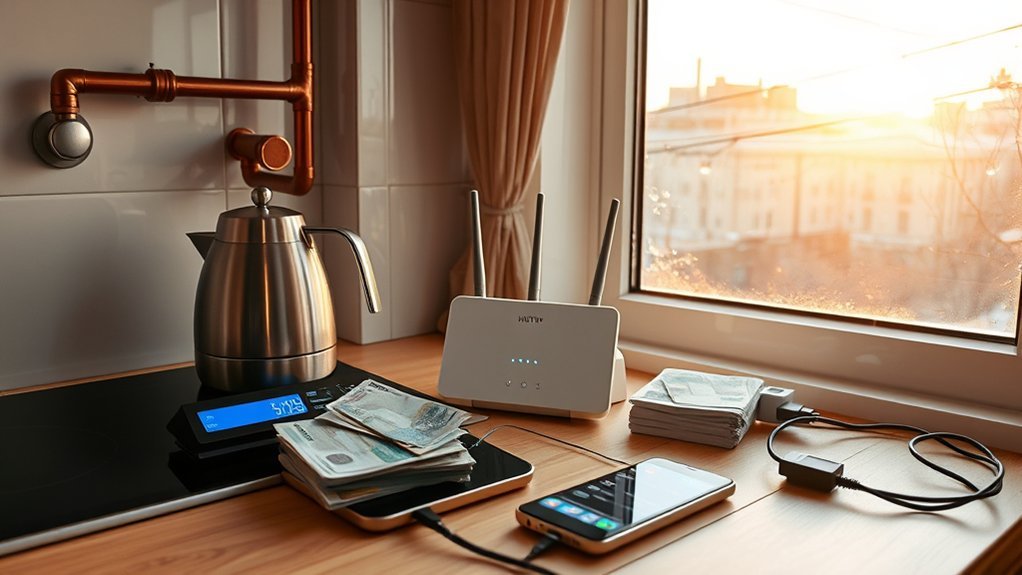You can live modestly in Ukraine for about $500 a month, comfortably for $800–$1,200, and closer to $1,200–$1,500 in Kyiv if you want central housing and more dining out. Rent varies a lot—Kyiv averages higher, Kharkiv and smaller cities are much cheaper. Food, utilities, and transport typically add $150–$400 depending on city and habits. Use city-specific figures to plan, and keep going to see detailed budgets and comparisons.
Cost of Living Overview in Ukraine

One person can expect to spend roughly $500–$1,500 per month living in Ukraine, depending on city and lifestyle choices.
You’ll use that range to plan: lower-end cities push totals toward $500, while Kyiv and more comfortable lifestyles approach $1,500. The Cost of Living shifts mainly with rent, food and utilities.
For food, self-catering runs about $100–$300 monthly, a clear saving versus frequent dining out. Utilities add roughly $20–$150 depending on apartment size and location.
Public transit is efficient and cheap; monthly passes cost $10–$30, reducing transport impact on budgets.
If you Visit Ukraine short-term, factor in initial setup and variation between central flats and an apartment outside city centers.
Compare Kyiv’s higher rents to Kharkiv’s markedly lower starting rents to decide where your money stretches farther. Use these figures to create a practical, city-specific budget.
Monthly Housing and Rent Prices by City

Although rent varies widely by city, you can use clear benchmarks to plan your housing costs: Kyiv is the most expensive, averaging 45,639 UAH/month (central units typically $700–$1,200 or 30,000–50,000 UAH). Lviv and Odesa sit midrange: Lviv ~19,900 UAH (central $500–$850 / 20,000–35,000 UAH), Odesa ~16,400 UAH (central $400–$1,000 / 16,000–40,000 UAH). Kharkiv is the cheapest among major cities, around 5,500 UAH with central apartments $200–$400 (8,200–16,400 UAH). Use per square metrics when comparing to markets like the United States; Ukrainian rents are lower per square and overall.
| City | Average Monthly Rent (UAH) |
|---|---|
| Kyiv | 45,639 |
| Lviv | 19,900 |
| Odesa | 16,400 |
| Kharkiv | 5,500 |
Practical tip: target neighborhoods by central vs peripheral rates to optimize budget and commuting time.
Food and Grocery Expenses Across Major Cities

When planning your monthly food budget, compare cities by typical self-catering ranges: Kyiv is the costliest at about $150–$300 (6,150–12,300 UAH), while Lviv, Odesa, and Kharkiv are more affordable at roughly $100–$200 (4,100–8,200 UAH).
You’ll find consistent patterns across markets and supermarkets: Kyiv’s higher prices reflect broader living costs; the other three cities give you more purchasing power for the same budget.
- Kyiv: $150–$300 / 6,150–12,300 UAH — higher-end groceries, imported items cost more.
- Kharkiv: $100–$200 / 4,100–8,200 UAH — economical staples, good local supply.
- Odesa: $100–$200 / 4,100–8,200 UAH — similar to Kharkiv; seafood can push totals up.
- Lviv: $100–$200 / 4,100–8,200 UAH — groceries comparable; budget café lunches $5–$10 (205–410 UAH), dinners $15–$40 (615–1,640 UAH).
Use these ranges to plan grocery frequency, shopping locations, and occasional dining out.
Utilities, Internet, and Household Bills

Monthly household bills in Ukraine typically run between $20 and $150, so you can expect wide variance based on city, apartment size and heating needs; Kyiv usually sits at the higher end (about $50–$150 for a standard apartment), while an 85 m² unit averages around $65.84 when you include electricity, heating, water and garbage.
Monthly Ukrainian household bills typically range $20–$150; Kyiv trends higher, with an 85 m² averaging about $65.84.
You’ll find internet is very inexpensive—plans at 60 Mbps+ cost about $5.80/month—so connectivity won’t be a major budget item. Compare that to utilities: heating and electricity drive seasonal peaks, especially in larger or poorly insulated units.
If you live in Kyiv center, expect higher utility components bundled with rent; outside the center, bills drop alongside lower rents. Factor in occasional service fees, maintenance charges for buildings, and variable water consumption.
Use average consumption benchmarks to estimate your own bill, and plan for winter surges. Overall, utilities and internet are affordable relative to Western cities, but heating remains the key cost variable.
Transportation and Commuting Costs

Beyond utilities and internet, daily movement around Ukrainian cities shapes your monthly budget more predictably. You’ll compare options by frequency and cost: single fares are about 8.00 UAH, while a monthly pass (~460 UAH) becomes cheaper if you commute more than ~58 trips monthly.
Subways in major cities offer wide coverage and English signage since EURO 2012, improving route efficiency for non‑native speakers.
- Public transport: 8.00 UAH per ride vs 460.00 UAH monthly — ideal if you make regular trips.
- Taxi/Uber: ~90.00 UAH start + ~20.00 UAH/km — convenient but cost rises quickly in congestion.
- Driving: gasoline ~58.54 UAH/liter — fuel is relatively affordable, but add parking and maintenance.
- Peak-hour impact: heavy traffic 8–10 am and 5:30–7:30 pm — many choose ride‑hailing to save time despite higher fares.
Use these figures to model your commute cost per month and pick the most cost‑efficient mix.
Entertainment, Eating Out, and Leisure Expenses

Although you can eat out affordably in Ukraine, your choice of venue will strongly shape daily costs: a mid‑range dinner for two averages about 1,500 UAH (range 1,000–2,600 UAH), fast food runs around 250 UAH per McMeal, draft beer about 45 UAH, and a cappuccino roughly 68 UAH, while cinema tickets and gym memberships sit near 100 UAH and 600 UAH per month respectively—figures that make casual dining and leisure considerably cheaper than in many Western European cities. You’ll find predictable, budget-friendly options: a McMeal or a beer keeps daily spend low, while occasional mid-range dining raises monthly food-out budgets. Cinema trips and gym access are affordable recurring costs to factor into lifestyle planning. Use the table below to compare typical unit costs and plan monthly allocations based on frequency.
| Item | Typical Cost |
|---|---|
| Mid‑range dinner (2) | 1,000–2,600 UAH |
| McMeal | 250 UAH |
| Draft beer (0.5L) | 45 UAH |
| Cappuccino | 68 UAH |
| Cinema / Gym | 100 UAH / 600 UAH |
Comparing Ukraine to the United States: Price Differences

You’ll see clear price gaps by category when you compare Ukraine and the United States: overall expenses are about 3.8 times lower in Ukraine, with groceries like bread at $0.68 versus $3.56 and restaurant meals at $6.41 versus $19.45.
Housing shows an even starker contrast—one-bedroom city-center rent averages $311.65 in Ukraine compared with $1,664.59 in the U.S.—and transportation follows suit (monthly pass $12.19 vs. $65.85).
You should also weigh differences in childcare and family costs, which can further widen the practical purchasing-power gap for households.
Price Gaps by Category
When you compare category-by-category costs, the United States runs about 3.8 times pricier than Ukraine, with the largest gaps in housing, childcare, and entertainment.
You can see clear, actionable differences across everyday spending categories:
- Dining out: Ukraine ~$6.41 for a basic meal vs. U.S. $19.45 — roughly one-third the U.S. price.
- Groceries: Loaf of bread $0.68 in Ukraine vs. $3.56 in the U.S. — big savings on staples.
- Transportation: Monthly transit pass ~$12.19 in Ukraine vs. $65.85 in the U.S. — public transit is far cheaper.
- Housing: One-bedroom downtown Kyiv ~$311.65 vs. U.S. $1,664.59 — largest routine expense gap.
Use these ratios to estimate your budget adjustments when comparing living costs.
Housing and Childcare Differences
Because housing and childcare are among the biggest budget items, comparing their prices shows why Ukraine feels markedly more affordable: a one-bedroom downtown apartment runs about $311.65 versus $1,664.59 in the U.S. (553.5% higher).
Basic utilities for a ~700 sq ft unit average $65.84 vs. $150.19, private preschool is roughly $259.96 vs. $1,387.27 (427.2% higher), and internet at $5.80 for 50 Mbps+ compares to $68.97—clear, quantifiable gaps you can use to adjust monthly and annual spending estimates.
If you relocate or budget remotely, expect rent, utilities and childcare to be your largest savings drivers. Factor lower internet costs into remote work calculations.
Use these ratios to model scenarios: single renter, family with preschoolers, or hybrid remote worker, and convert monthly differences into annual savings to guide decisions.
Budget Examples: Single, Couple, and Family Monthly Costs

To plan your monthly budget in Ukraine, consider that a single person typically spends about $555 (23,143 UAH) excluding rent, while a family of four averages roughly $1,936 (80,731 UAH).
Rent and utilities shift totals considerably—expect a one-bedroom in Kyiv near $410 versus about $200 in Kharkiv, and utilities from $50–$150 monthly.
Use grocery ($100–$250) and dining estimates ($100 monthly) to adjust for your household size and lifestyle.
Single Person Budget
Although costs vary by city and lifestyle, you can expect a single person in Ukraine to spend roughly $555–$1,500 monthly excluding rent, with Kyiv at the higher end ($800–$1,500) and Kharkiv nearer the lower end ($500–$1,000).
You’ll budget based on food, utilities, transport and discretionary spending.
- Food: self-catering runs $100–$300/month in Kyiv, Lviv, Odesa; choose markets to save.
- Utilities: expect $50–$150/month; winters push costs higher in colder cities.
- Transport: public transit averages $10–$30/month; it’s inexpensive compared with Western cities.
- Discretionary & misc: the remaining balance covers mobile, internet, occasional dining and small leisure.
Use these ranges to build a city-specific plan and prioritize based on commute and dining habits.
Family & Couple Costs
When you compare household sizes, costs scale predictably: a single person spends roughly $555/month excluding rent.
A couple will typically need about $1,100–$1,400 depending on city and habits, and a family of four averages around $1,936/month (80,731 UAH) excluding rent.
If you’re a couple, you’ll see near-doubling of groceries and utilities versus a single, but some per-person savings on shared items and a single rent payment can keep total costs under $1,400 in most cities.
Families face higher grocery bands ($200–$600) and predictable utility increases ($80–$180).
In Kyiv include rent impact: a one-bedroom at ~$410 shifts budgets significantly.
Frequently Asked Questions
How Much Does It Cost to Live Comfortably in Ukraine?
You’d need roughly $555–$1,500 monthly to live comfortably in Ukraine, varying by city and lifestyle; Kyiv trends $800–$1,500, Odesa $700–$1,400, with utilities, food, and transit driving most differences.
How Far Does $100 Go in Ukraine?
It stretches: for groceries, it buys 4–8 days; for eating out, 10–20 budget meals; for transport, several months’ passes; for utilities, a significant portion of a month; for rent, only a partial contribution.
Can a US Citizen Live in Ukraine?
Yes — you can live in Ukraine, but you’ll need visas or residency, expect lower living costs versus the U.S., factor in safety concerns due to conflict, and align income or savings with local expenses like $555/month (excl. rent).
Is 1 000 USD a Lot in Ukraine?
Yes — $1,000 goes far in Ukraine; you’ll cover rent, utilities, food and transport comfortably in many cities. Compared to Western costs, it’s economical, letting you save or enjoy modest dining and activities monthly.
Conclusion
Think of living in Ukraine like steering a reliable, efficient ship through varied waters: you’ll find calm, affordable bays in smaller cities and busier, pricier ports in Kyiv or Lviv. With concrete monthly figures guiding your choices, you can chart a practical course—trim costs by choosing location, housing, and transport wisely. Compare line items to your current expenses, adjust sails, and you’ll navigate a budget that’s both realistic and resilient.


